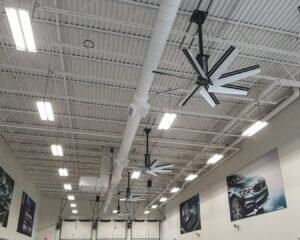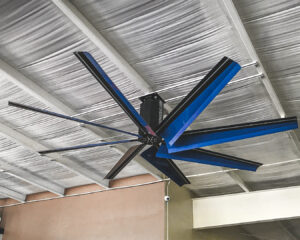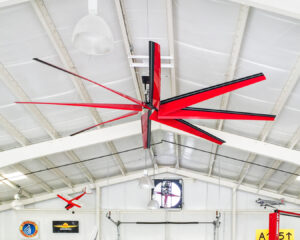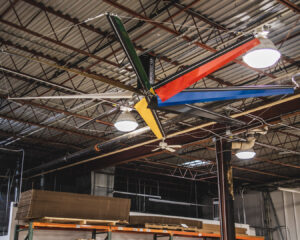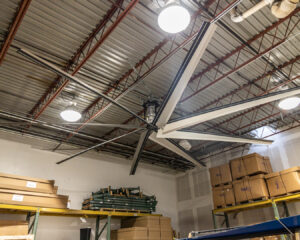At its essence, any manufacturing facility has extensive operations in action over an expanse of area. Regardless of the inherent nature of the facility, whether it be storage or an active manufacturing site the even distribution of air throughout the facility is critical both in comfort, preservation, and energy costs. While a facility may have a lot of human or machine activity, the use of HVLS systems to evenly distribute air and optimize HVAC usage is critical to achieving peak performance.
The Need for Change
Within a manufacturing facility conditions can be very extreme with massive ceilings and hot machines running non-stop. For both industrial equipment and staff on the floor the environment in the facility can have a massive impact and production. Inconsistency in temperature and poor regulation of the HVAC system can hurt production efficiency. Comfortable conditions for floor workers can greatly improve moral and production capacity – when working it is best to focus on the task at hand, not being uncomfortable from the conditions.
As the owner or manager of a large facility, optimize performance is critical to the bottom line. An HVLS fan can help you achieve a higher level of productivity while keeping your staff and equipment safe and more comfortable in better operating conditions.
The Ultimate Solution
You would think that air condition and heating in a facility would achieve the desired result of environmental conditions, but oftentimes this is not the case. An HVAC system can push or pull hot and cold air but it does work efficiently enough when a facility is very large with high ceilings and large open loading docks. Trying to regular a facility with AC and heat can be extremely costly and ineffective.
What do you do when HVAC is not enough?
Consider HVLS, High Volume Low Speed Fans. An HVLS Fan is a system which can move an absolutely massive amount of air with the very low energy usage of spinning just 1 motor.
Think about how easily a human can create a breeze for an ant, that is HVLS.
HVLS Fans Systems
Structurally HVLS fans is very similar to a standard ceiling fan you’d find in a home or office – they’re just 4-10x larger.
HVLS fans can range from big 8 foot fans to absolutely MASSIVE 24-foot fans which can be used in systems of multiple fans to cool or move heat around in the largest of facilities. 8 foot fans are great for smaller big spaces like large homes, hotels, shopping malls, and restaurants, while 20-24 foot fans can support massive manufacturing and warehouse facilities.
The way an HVLS fan is built, each blade has such a large surface area that with each rotation a huge gust of air is moved not only evening out the temperature throughout a facility but improving the efficiency of an HVAC system and saving you up to 33% year round.
In the summer the wind speeds created by an HVLS system capitalize on the human trait of sweating, this fan can help everyone in a commercial location or facility feel up to 15 degrees cooler.
In the winter many facilities face issues where the heating system tries to regulate temperature but all of the heat rises and sits on the ceiling, an HVLS system easily pushes this hot area down and throughout the space creating an even, warm, and efficient space for everyone.
Warehouses and Storage Facilites
When advertising a climate-controlled facility, having HVAC in place and actually effectively controlling the climate are two very different things.
Managing the temperature and humidity in a climate-controlled facility with large floors and massive ceilings is extremely difficult without the support of another system such as fans.
For both workers, customers, and products or goods in a warehouse, keeping the temperature and humidity under control are critical to the longevity of your things. Extreme heat, moisture, extreme cold, and other climate factors can easily destroy goods and machinery over time, especially things made of high-risk materials such as metal, wood, masonry, and more.

